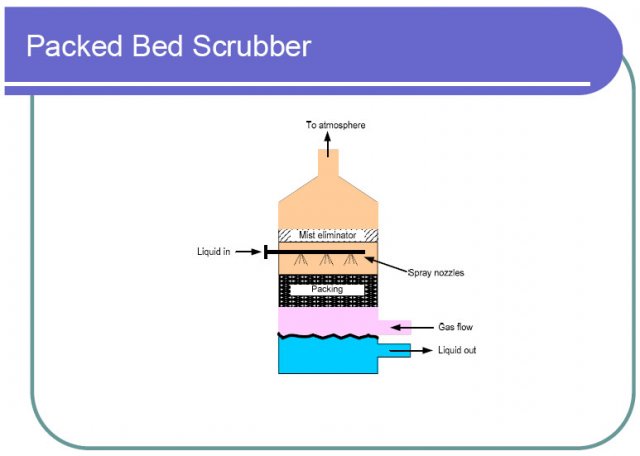Monitoring by Control Technique - Wet Scrubber For Gaseous Control
Description
In wet scrubbing processes for gaseous control, a liquid is used to remove pollutants from an exhaust stream. The removal of pollutants in the gaseous stream is done by absorption. Wet scrubbers used for this type of pollutant control are often referred to as absorbers. Most absorbers have removal efficiencies in excess of 90 percent, depending on pollutant absorbed. The scrubbing liquid, usually water, is used to absorb the pollutant. Other liquids, such as dimethylaniline or amines, may be used as the absorbent for gases with low water solubility (i.e., hydrocarbons or hydrogen sulfide). The chosen absorbent should have a high solubility for the gaseous stream and should be relatively inexpensive. Wet scrubbers can also be used to remove particulate matter; however, this section addresses only wet scrubbers for gaseous control (e.g., acid gases, water soluble inorganic contaminants, and volatile organic compounds).
The driving force of the absorption process is related to the amount of soluble gas in the gas stream and the concentration of the solute gas in the liquid film in contact with the gas. When water is used as the absorbing material, other chemicals may be present to react with the pollutant being absorbed to reduce the concentration. Liquids other than water may require absorbent separation and scrubbing liquid regeneration to help lower costs of the scrubbing liquid.
Wet scrubbers utilize large surface areas to allow intimate contact between the liquid and gas stream. The creation of the large surface area is accomplished by passing the liquid over a variety of media (packing, meshing, grids, or trays) or by creating a spray of droplets. Wet scrubber designs include spray tower, tray-type, and packed-bed scrubbers, which are generally referred to as low-energy scrubbers.
Packed bed scrubbers are commonly used for gas absorption. This type of scrubber spreads the liquid over packing material in order to provide a large surface area for liquid/gas interaction. Packed bed scrubbers are classified according to the relative direction of the gas and liquid flows. In the counter-current design, the liquid is introduced at the top of the tower using sprays or weirs and flows downward over the packing material. The contaminated gas stream enters at the bottom of the tower and flows upward through the packing.
Wet scrubbing systems are susceptible to several operating problems, especially if the pressure differential, liquid flow, and gas flow are not kept relatively constant. Common problems include: low gas flow rate; low liquid flow rate; condensation of aerosols in the system; poor liquid distribution; use of liquid with high pollutant concentration; tray/plate collapse; air inleakage; pollutant re-entrainment; freezing/pluggage of lines; and scaling.
Specific information about wet scrubbers can be found from EPA Fact Sheets and the EPA Air Pollution Control Cost Manual, Section 5, Chapter 1 - Wet Scrubbers for Acid Gases (Sixth Edition).
For more information, see the box More about Wet Scrubber For Gaseous Control.
Monitoring Information
The primary indicators of wet scrubber performance are pressure differential, liquid flow rate, and scrubber liquid outlet concentration. The less significant indicators of gaseous pollutant control efficiency for wet scrubbers are gas flow rate, neutralizing chemical feed rate, and scrubber outlet gas temperature. Parameters to monitor as an alternative to scrubber liquid outlet concentration include scrubber liquid pH, scrubber liquid specific gravity, and scrubber makeup/blowdown rates. For systems that control gaseous streams with low particulate matter loadings, there is no advantage to monitoring the scrubbing liquid solids content.
For more information, see the box Monitoring and the CAM Rule.
Costs
Costs of wet scrubbers are discussed in the EPA Air Pollution Control Cost Manual*, Section 5, Chapter 1 - Wet Scrubbers for Acid Gases (Sixth Edition) (PDF)(60 pp, 290 K, About PDF). Costs of monitoring systems, both Continuous Emission Monitors and parametric monitoring systems, are addressed in the EPA Air Pollution Control Cost Manual*, Section 2, Chapter 4 - Monitors.(42 pp, 542 K, About PDF)

- EPA Fact Sheet - Packed-Bed/Packed-Tower Wet Scrubber, EPA-452/F-03-015 (PDF)(6 pp, 37 K, About PDF)
- EPA Fact Sheet - Impingement Plate/Tray Tower Scrubber, EPA-452/F-03-018 (PDF)(5 pp, 30 K, About PDF)
- EPA Fact Sheet - Spray Chamber/Spray Tower Wet Scrubber, EPA-452/F-03-016 (PDF) (6 pp, 39 K, About PDF)
- Air Pollution Control Cost Manual*, Section 5, Chapter 1 - Wet Scrubbers for Acid Gases (Sixth Edition) (PDF)(60 pp, 290 K, About PDF).
- Training Video - Air Pollution Control Devices - Wet Scrubbers for Particles (MP4) (zip)

- CAM TGD Appendix A: Wet Scrubbers
- CAM Rule(48 pp, 408 K, About PDF) - Federal Register - October 22, 1997
